Video of the Week:
Common Tomato Problems, Part 2
Turfgrass:
Bermudagrass Control
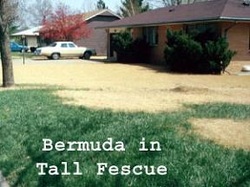
Spray about the middle of this month (or when the bermuda is growing well) and again about a month later if there is any green left in the bermudagrass. Use glyphosate (2% solution). Wait two more weeks and reseed. It may also be helpful to scalp (mow as low as possible and remove clippings) the lawn two weeks after the first application so that dead grass does not prevent the glyphosate from reaching the recovering bermuda. (Ward Upham)
Slime Molds
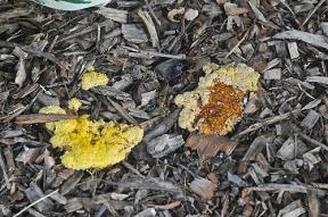
Homeowners often are concerned that this is a disease organism that will kill the grass, but slime mold feeds on bacteria, other fungi, and dead organic matter. It simply uses the turf as a structure on which to grow. However, slime mold can damage turf by completely covering leaf blades and interfering with photosynthesis. Chemical control of slime molds is not necessary. Use a broom or a heavy spray of water to dislodge the mold.
Slime molds on mulch often attract attention because of their bright colors and disgusting appearance. Common names are often quite descriptive. For example, the "dog vomit" slime mold is a bright, whitish color that resembles its namesake. It eventually turns brown and then into a hard, white mass. There is also the "scrambled egg" slime mold, "the yellow blob" slime mold and the "regurgitated cat breakfast" slime mold. Slime molds do not hurt anything, but most people do not find them attractive and want to get rid of them. Simply use a shovel to discard the offensive organism and then stir up the mulch for aeration. (Ward Upham)
Vegetables:
Hornworms on Tomatoes
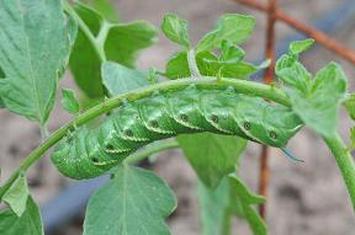
The larva is the damaging stage and feeds on the leaves and stems of the tomato plant, leaving behind dark green or black droppings. Though initially quite small with a body about the same size as its horn, these insects pass through four or five larval stages to reach full size in about a month. The coloration of this larva causes it to blend in with its surroundings and is often difficult to see despite its large size. It eventually will burrow into the soil to pupate. There are two generations a year. This insect is parasitized by a number of insects. One of the most common is a small braconid wasp. Larva that hatch from wasp eggs laid on the hornworm feed on the inside of the hornworm until the wasp is ready to pupate. The cocoons appear as white projections protruding from the hornworm's body. If such projections are seen, leave the infected hornworms in the garden. The wasps will kill the hornworms when they emerge from the cocoons and will seek out other hornworms to parasitize.
Handpicking is an effective control in small gardens. Bt (Dipel, Thuricide), spinosad (Conserve; Borer, Bagworm, Leafminer & Tent Caterpillar Spray; Colorado Potato Beetle Beater Conc; Captain Jack's Dead Bug Brew, Monterey Garden Insect Spray), cyfluthrin (Bayer Vegetable & Garden Insect Spray) and other insecticides may also be used to control hornworms. (Ward Upham)
Weird Squash, Cucumbers, or Melons
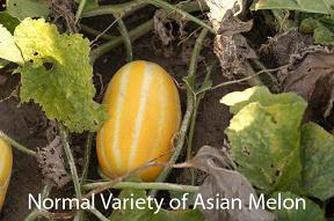
They often wish to know if that fruit had cross-pollinated with another vegetable close by. In such cases, the gardener is assuming that cross-pollination will affect the fruit. Such is not the case. The characteristics of the fruit is determined by the mother plant and is not affected by cross-pollination. However, there will be a problem if seed is saved for the next year from a flower that was cross-pollinated. All bets are off on what you will get if that happens.
So how do we end up with this weird fruit? Though it could be that the gardener had forgotten exactly what he planted, more likely is that the seed he planted had been cross-pollinated before packaging. Another possibility is that it came from seed that came from fruit that had rotted in the garden the previous year. Regardless, don’t worry about planting different cultivars of squash or cucumbers or melons close to one another. Though cross-pollination may occur, the fruit will not be affected. (Ward Upham)
Raccoons and Sweet Corn
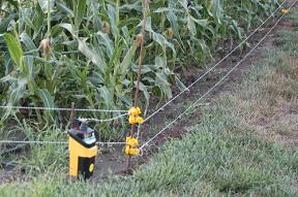
– Two or more wires must be used. Place the first about 5 inches above the ground and the second 4 inches above the first (or 9 inches above ground). Raccoons must not be able to crawl under, go between or go over the wires without being shocked.
– Fence posts used for electric fences work well for this application (go figure), as do the insulators used to support the electric wire.
– It is much easier to use the woven electric wire with strands of wire embedded than to use a solid metal wire. The woven wire is easier to bend around corners and to roll up when done for the year.
– Though both the plug-in and battery operated fencers work, the battery operated types allow more versatility in where corn is grown. One set of batteries is usually sufficient for the season. In my case, I pull the battery out of an old tractor that is not used often. It will also last the season if fully charged at the beginning. My fencer is probably on for a total of a month.
– Start the charger before the corn is close to being ripe. Once raccoons get a taste of the corn, they are more difficult to discourage.
– Control weeds near the wire. Weeds can intercept the voltage if they touch a wire and allow raccoons entry beyond the weed.
– Check the wire occasionally to make sure you have current. This can be done easily (but unpleasantly) by touching the wire. There are also tools that will measure the voltage available for sale. They are worth the money. (Ward Upham)
Fall Gardening: Cole Crops
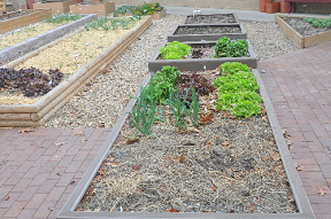
Plant slightly deeper than you would in the spring so the seed stays cooler and the soil around the seed stays moist longer. Plant more thickly and thin later. The plants may need to be protected from rabbits through the use of fencing.
Use light amounts of fertilizer before planting. For example, apply 1/4 cup of a low-analysis fertilizer (6-7-7) per 10 feet of row. Sidedress two weeks after transplanting or four weeks after sowing seed by applying 2 tablespoons of a 16-0-0 or 1 tablespoon of a 27-3-3, 30-3-4 fertilizer, or something similar per plant.
Watering must occur more frequently because seed should not be allowed to dry out. Overhead watering often causes soil to crust, making it more difficult for young, tender plants to emerge. Prevent this by applying a light sprinkling of peat moss, vermiculite or compost directly over the row after seeding. Even better, use a soaker hose right next to the row to allow water to slowly seep into the ground.
Plants should be ready for harvest in late September to early October, with broccoli side shoots developing well into November, weather permitting. (Ward Upham)
Fruit:
When to Pick Blackberries
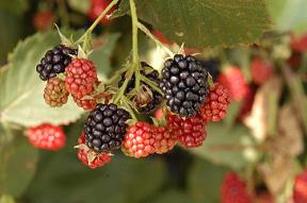
Two major characteristics determining maturity for harvest are fruit color and ease of separation. Blackberries usually develop a dull, black color with plump, juicy fruitlets as they ripen. The berries soften and produce the characteristic flavor. Full color often develops before the berries separate easily. Pick the berries by gently lifting the berry with the thumb and fingers. The receptacle, or center part of the fruit, remains in the fruit when blackberries are harvested, unlike raspberries, which leave the receptacle on the bush. Take care not to crush the berries or expose them to the hot sun. When possible, avoid picking berries when they are wet. They'll probably need picking every second or third day. Cool the berries immediately after harvest to extend shelf life. Keep them refrigerated under high relative humidity and use within three to five days. (Ward Upham)
Pests:
White-lined Sphinx Caterpillar
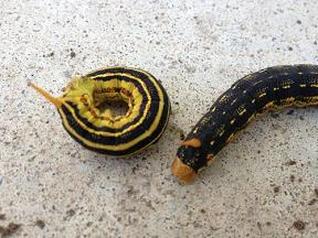
The caterpillar is highly variable in coloration but are often green with black stripes and yellow and orange markings. High populations can result in larvae that are very dark to almost black. Though the horn on the back end of the larva may look dangerous, it is not. It will neither sting or penetrate the skin. Sphinx moths received their name from the habit of some of the caterpillar raising its head and striking a sphinx-like pose when at rest.
Control of this insect is rarely called for as it most commonly feeds on weeds. However, if control is warranted due to feeding on desirable plants, follow the recommendations given in the accompanying article on tomato hornworms. (Ward Upham)
Contributors: Ward Upham, Extension Associate
 RSS Feed
RSS Feed
